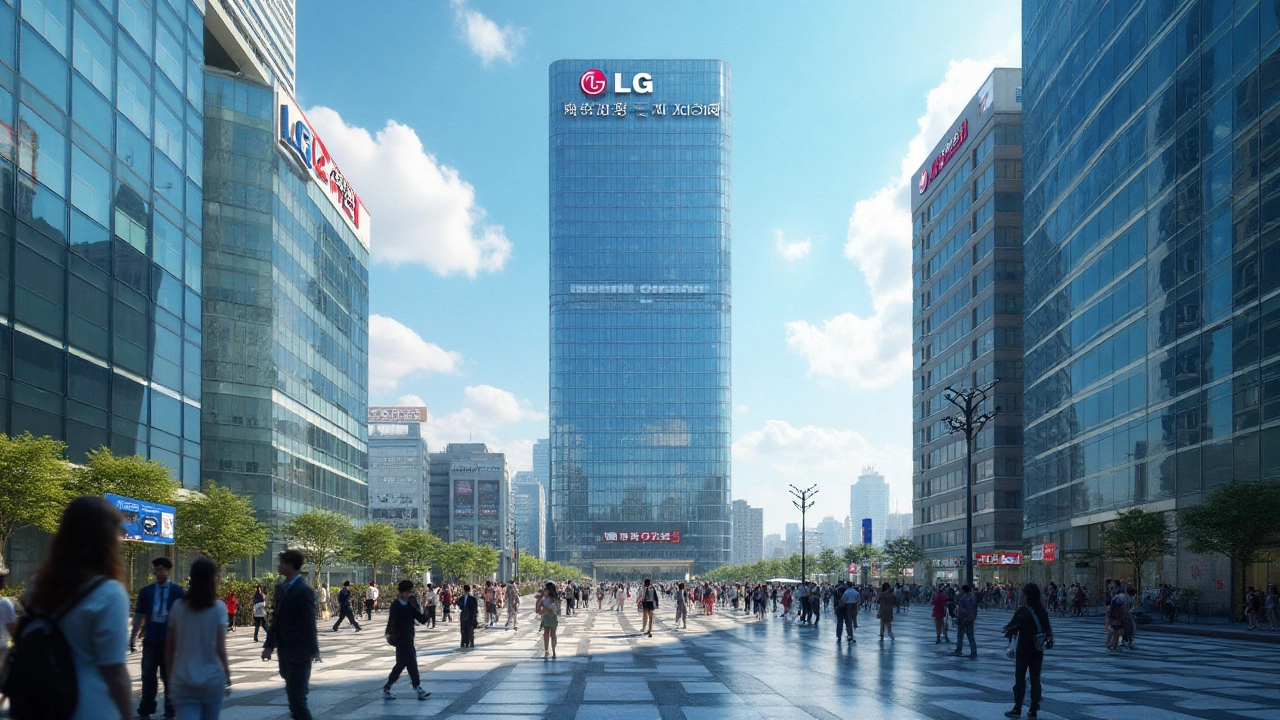
The world of electronics is filled with intricate corporate webs, often casting shadows of mystery over brand ownership and affiliations. LG Electronics, a name synonymous with futuristic television technology, particularly the beloved 4K models, is frequently a topic in such discussions. Whether you're a tech enthusiast or simply someone eager to add another device to your living room setup, there's a curiosity about where this sleek technology originates and who holds the reins. With murmurs about China’s influence over global tech brands, it's natural to wonder if LG falls within that realm.
This exploration seeks to untangle the threads, shedding light on the true ownership structure of LG and the extent of its connections with China. As we unravel the facts, it becomes apparent that LG maintains its South Korean heritage while strategically engaging in global markets, including the vast landscape of China. Join us as we journey through LG's history, its business dynamics, and what positions it as a key player in the modern tech scene.
- Introduction to LG
- LG's Ownership and Origin
- Business Relations with China
- Manufacturing and Global Influence
- Future of LG in the Television Market
Introduction to LG
To unravel the origins of LG and its enduring prominence in the electronics world, we must journey back to its inception in South Korea. Founded in 1958, under the name GoldStar, the company was born in the recovering aftershock of the Korean War, exemplifying resilience and innovation. LG, an abbreviation of 'Lucky-Goldstar', mirrors this dual heritage, although international markets now recognize it simply by the initials. From producing the first radios and TVs for the Korean market, LG rapidly gained a foothold in the regional electronics scene, laying the groundwork for its global ambitions. As the years unfolded, the brand's commitment to quality and cutting-edge technology propelled it onto the world stage, marking its presence in homes worldwide.
With the release of its pioneering products, such as the first Korean-made television set, LG has more than once set standards in the consumer electronics industry. The company's ethos—'Life's Good'—is embodied in every endeavor, aiming to blend functional innovation with aesthetic appeal. This philosophy helped shape an enterprise that thrives on creative challenges, continually pushing the envelope in technology and quality. The company's evolution mirrors a broader South Korean narrative of rapid modernization and economic growth during the latter half of the 20th century. As an early adopter and developer of new technologies, LG has carved a niche in the bustling market of 4K televisions, offering advanced display technologies that appeal to tech enthusiasts and casual users alike.
Emphasizing its global perspective, LG has embraced the challenge of weaving various cultural innovations into its product lines, establishing production bases and R&D centers across multiple continents, including influential sectors in China. It’s important to note that this global outlook hasn't diluted its unique South Korean identity. Instead, it has positioned LG as a versatile player capable of adapting and thriving in diverse markets. This adaptability is reflected in its consistent performance in consumer electronics, as showcased by the substantial popularity of its 4K TV models, which present a seamless blend of affordability and cutting-edge visual technology. As per a report by Statista, LG holds a significant share in the global TV market, a testament to its dynamic strategies and robust product appeal.
"LG Electronics is a beacon of South Korea's industrial achievement, a testament to years of innovation and resilience in the face of global economic challenges," states a commentary from The Economist.
The history of LG is not merely a tale of corporate success but a narrative of inspired vision and technological courage. As technology continues to evolve at a breakneck speed, LG remains at the forefront, ready to meet new challenges with ingenuity and determination. Its ongoing ambition to enhance the quality of life through technology resonates with consumers and industry peers alike, cementing its position as not just a brand, but a force shaping modern living.
LG's Ownership and Origin
Established in the heart of South Korea, LG Electronics has become a household name synonymous with innovation and quality. The acronym "LG" stands for "Lucky Goldstar," a name that carries a rich legacy in the field of consumer electronics. While televisions, refrigerators, and smartphones often come to mind, the company's journey sprouted from humble beginnings in the 1950s, when it began as Lak-Hui (pronounced 'Lucky') Chemical Industrial Corp, eventually laying down the foundation for its electronics arm that emerged in the early 1960s. The brand took significant strides in its expansion and rebranded itself as LG, encapsulating the spirit of both "Life's Good" and its original namesake.
Staying true to its roots, LG is headquartered in Seoul, South Korea, and it remains under the umbrella of the LG Corporation conglomerate. With over a hundred subsidiaries worldwide, LG sustains its independence and South Korean identity despite its extensive international reach. The company is publicly traded on both the Korean Stock Exchange and the London Stock Exchange, exhibiting a high level of transparency and international engagement. According to a report from 2021, the LG Corporation, as its parent company, holds a significant percentage of shares, thereby maintaining a robust control over the operations and strategic directions of LG Electronics.
"Our aim has always been to create products that enrich our customers' lives and create new experiences," said an LG senior executive in a 2019 interview, highlighting the company's commitment to its founding principles.
The corporate culture at LG emphasizes both tradition and technological advancement, positioning itself as a leader in innovation while being deeply rooted in its South Korean origins. This duality is a testament to the company's ability to maintain its integrity while adapting to global market changes. While many may speculate about LG's ties with regions like China, it's vital to understand that LG Electronics operates independently and takes pride in its heritage. This is evident in their leadership structure and the way decisions are heavily influenced by the parent company in Seoul. The nuanced balance between embracing globalization and holding onto foundational origins is what makes LG's ownership model intriguing and worth exploring for technology enthusiasts and business analysts alike.

Business Relations with China
In today’s interconnected world, the relationship between conglomerates such as LG and China serves as a splendid example of globalization at play. With China’s burgeoning market and industrial capabilities, it is no surprise that numerous tech giants, including LG, have established significant business links there. It’s not just about selling products; it's about weaving an intricate web of manufacturing and partnership ventures that transcend borders. While LG remains proudly South Korean in origin and operation, its strategic alliances in China deserve a closer look. These collaborations manifest primarily in production and distribution channels, ensuring that high-quality 4K televisions reach consumers worldwide efficiently and affordably. Yet, despite these ties, ownership remains firmly grounded in South Korea, maintaining LG's autonomy and brand ethos.
The scope of LG's activities within China is broad and multifaceted. Primarily, it involves leveraging China’s industrial vigor to optimize manufacturing processes. Facilities in Chinese regions often participate in assembling components or even complete products to meet international demand. Moreover, China offers an abundant market ripe for LG's expansive product lineup. Partnerships range from joint ventures with local companies to direct investments that bolster both production capacity and innovation. It's worth noting, though, that China's role, while pivotal, does not encapsulate the entire picture of LG’s operations; rather, it stands as a significant chapter in a global narrative.
International Partnerships and Synergies
While LG's relationship with China is substantial, it is part and parcel of a more extensive network of international collaborations. These partnerships are crucial in maintaining LG’s competitive edge in developing cutting-edge technologies, especially in the realm of 4K televisions. The synergy achieved through these international partnerships has allowed LG to enhance its R&D initiatives and optimize its supply chain, thus fostering innovation while maintaining cost-effectiveness. A key element of this collaboration is technological exchange and expertise sharing, a practice that enriches all involved parties. Still, at the heart of it, LG remains a distinct entity with decision-making processes framed by its headquarters in Seoul. As a result, any strategic choice to collaborate with Chinese firms is primarily driven by shared interests and mutual benefits, rather than by any shift in ownership dynamics.
"LG's strategic presence in China is less about shifting ownership and more about forging robust partnerships that drive mutual growth in the technological frontier," says Kevin Lee, a renowned industry analyst.
The presence of LG in China is thus a testament to its adaptability and foresight in navigating the complexities of international business landscapes. As with any global enterprise, the relationships LG builds with Chinese entities are crucial for its long-term strategy. However, the brand continues to keep a distinctive South Korean identity, ensuring that any international partnership, including those with China, aligns with LG’s core values and goals.
Manufacturing and Global Influence
When it comes to the manufacturing prowess of LG, it’s a fascinating tale of global footprint and strategic alliances. With headquarters stationed in the bustling heart of Seoul, South Korea, LG has clearly leveraged its geographical position to expand far and wide across the globe. Its manufacturing landscape is chock-full of facilities not just within its home borders, but in strategic locations worldwide. These factories are a testament to LG’s commitment to bringing high-quality 4K televisions and other electronic products to consumers globally. In Korea alone, LG's Pyeongtaek campus stands as a colossal hub for innovation and production. Meanwhile, venture out into China, and you’ll uncover another layer of LG’s expansive infrastructure, where it capitalizes on local expertise and logistical benefits.
Now, it’s a common misconception that a South Korean company like LG might be owned by China simply due to its manufacturing ties. But the reality is far from it. Having its products assembled in Chinese plants doesn’t equate to ownership changes. This decision is purely operational, optimizing costs and distribution channels effectively. China’s business-friendly policies over the years have made it an attractive locale for manufacturing heavyweights, including LG. This relationship does not indicate ownership but demonstrates a savvy business maneuver. As Arthur Davis, an industry analyst, once said, “The lines of global manufacturing don't blur ownership; they clarify international collaboration.”
On a broader scale, LG’s global influence extends into the innovation and adaptation of its technologies to suit diverse markets. Whether it's the Middle East or North America, LG tweaks its offerings by integrating the cultural and technological nuances of the region. For example, LG's approach to smart technology in televisions incorporates region-specific applications catering to local content demands. As proof, take a look at their television's adaptation for the North American market with integrated apps like Netflix and Hulu, offering a seamless experience tailored for American audiences. Significant investments in research and development globally allow LG to push the envelope in electronics technology, ensuring its products remain at the cutting-edge.
To give you an idea of the scale LG operates at, let's consider the global shipment numbers. According to recent statistics from 2023, LG ranked among the top three television manufacturers worldwide, with a remarkable share of the 4K TV market. Here’s a small snapshot:
| Year | 4K TV Market Share | Rank |
|---|---|---|
| 2021 | 18% | 3rd |
| 2022 | 19.5% | 2nd |
| 2023 | 21% | 2nd |
Through this network, LG achieves a commendable balance, managing to flexible production while maintaining the high standards it is known for. This strategy not only boosts its brand reputation but also enhances customer satisfaction across the map. As LG continues to navigate the ever-changing tides of the technology market, it is assuredly positioned to innovate while retaining its South Korean essence, no matter which corner of the world its products might be crafted.

Future of LG in the Television Market
As we look forward to what lies ahead for LG in the ever-evolving world of 4K televisions, it's clear that the company has set its sights on both maintaining and expanding its influential position in the industry. LG's commitment to innovation has been a cornerstone of its success, and with emerging technologies such as OLED and MicroLED, the future appears brighter still. The advancements LG is undertaking in display technology are likely to redefine user experiences, enhancing color accuracy and contrast far beyond what we have today. This ambition to lead innovation was echoed in a recent statement by CEO William Cho, who mentioned LG's strategic direction towards a 'seamless integration of AI and IoT in future television models.'
Moreover, LG is investing heavily in research and development, with a particular focus on sustainability and energy efficiency. It's no secret that global consumers are becoming increasingly environmentally conscious, a trend that TV manufacturers ignore at their peril. LG’s initiatives to reduce the carbon footprint of its manufacturing processes align with wider industry shifts towards green tech solutions. Products that offer smarter energy use not only cater to this eco-conscious audience but also give LG a competitive edge, creating a unique selling proposition that resonates with today's buyers. Analysts anticipate that LG’s future models may feature renewable materials and innovative power-saving modes, setting new industry standards.
The competitive landscape doesn't just favor technological refinement but also encompasses strategic geographical expansions. LG has been eyeing both established markets and emerging economies, where television ownership is quickly becoming attainable for broader demographics. Markets like India and Southeast Asia present opportunities to exponentially grow the customer base, buoyed by rising middle-class populations eager to upgrade home entertainment systems. Here, LG's comprehensive market strategies, which include localized content collaborations and aggressive pricing, are crucial to gaining ground against rivals.
Adding another layer to the company's blueprint for the future, LG plans on deepening its engagement with the digital economy. By integrating smart TV functionalities that easily dovetail with internet-based content platforms like Netflix and Amazon Prime, LG is ensuring that its customers have access to the widest range of content available with unrivaled convenience. This strategy is a calculated move to secure a dominant share in the smart home ecosystem, capitalizing on the trends of voice-assisted controls and seamless device interconnectivity that are becoming part and parcel of modern life.
CNET predicts, "The future of TV is more about the integration and less about the screen size. LG's approach to sync televisions as centerpieces of Smart Homes exemplifies an adaptive strategy for the future."
Looking at the financial vantage point, industry forecasts indicate a steady market growth rate, bolstered by consumer demand for high-quality television experiences. LG's proactive adoption of new technologies and its commitment to enriching consumer lifestyles figures significantly in its ongoing market ascent. Projections suggest that the brand's aggressive stance on expanding 8K television technology will see it capture a substantial portion of the high-end market segment, thereby reinforcing its pedigree as a global powerhouse in home entertainment.